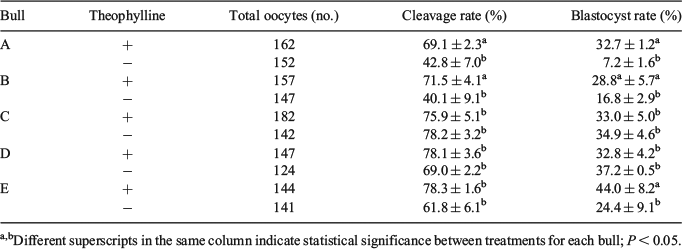120 Theophylline: the Key for Bulls with Low In Vitro Blastocyst Rates?
S. M. Bernal-Ulloa A and S. E. Ulbrich AETH Zurich, Animal Physiology, Institute of Agricultural Sciences, Zurich, Switzerland
Reproduction, Fertility and Development 30(1) 199-200 https://doi.org/10.1071/RDv30n1Ab120
Published: 4 December 2017
Abstract
Although many efforts have been made to improve the sperm normal penetration ability for in vitro embryo production (IVP), sperm capacitation in bovine remains a bottleneck for in vitro fertilization (IVF). The variable responses of sperm to the different supplements in IVF medium makes the process suboptimal for every bull. Theophylline, a methylxanthine, has recently been reported to enhance and maintain in vitro blastocyst production due to prolonged motility and longevity of bovine sperm (Kang et al. 2015 J. Reprod. Dev. 61, 99-105). Here, we evaluated the effects of theophylline supplementation during IVF on developmental rates of bulls with known low and average blastocyst production under standard conditions. A total of 1498 cumulus–oocyte complexes were obtained by slicing from bovine ovaries. Cumulus-oocyte complexes were submitted to in vitro maturation (IVM) for 24 h. In vitro fertilization was performed for 19 h with (2.5 mM) or without theophylline using frozen–thawed sperm from 5 different bulls at a final sperm concentration of to 2 × 106 cells mL−1. Two of the bulls had a previous report of low blastocyst rates (A, B) and 3 showed an average blastocyst production (C, D, E). After IVF, presumptive zygotes were cultured in vitro for 8 days until the blastocyst stage. Cleavage and blastocyst rates were evaluated 3 and 8 days after IVF, respectively. R software (

|
The authors thank Susanne Meese and Ulrich Witschi from Swissgenetics for the cooperation and donation of frozen bull sperm.


